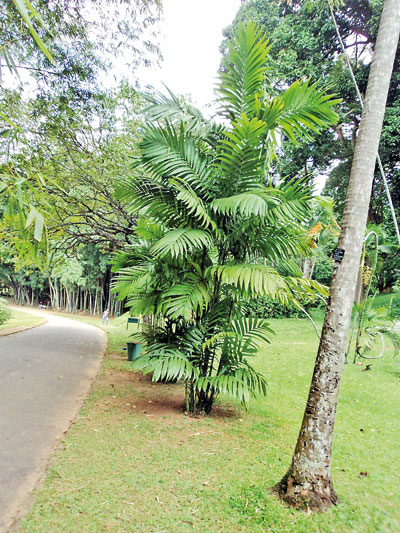News
Non native palm introduced 150 years back, becomes invasive
View(s):By Malaka Rodrigo
While native plant species like Ran Dothalu continue to decline in Sri Lanka, a non-native ornamental palm is rapidly spreading through the country’s southwestern rainforests, posing a threat to native biodiversity, according to a recent study.
The palm in question, Areca triandra, is native to Southeast Asia and has now naturalised in Sri Lanka, particularly in disturbed forest edges and shady understory habitats. First introduced to the country in 1867 via the Royal Botanic Gardens in Peradeniya, it later gained popularity as a hardy, low-maintenance landscaping plant.
Dilini Wickramasinghe of the department of forestry and environmental science at the University of Sri Jayewardenepura, who co-authored the study, explains that A. triandrahas established itself in significant numbers. In Meethirigala and Yagirala Forest Reserves — the main focus of the research — the species accounts for 56% to 66% of stems taller than one meter and contributes 52% to 76% of the crown cover.

Invasive Areca triandra. Pic courtesy Flora of Sri Lanka
The study found that the palm produces prolific quantities of bright red fruits — up to 8,000 per 400 square metre plot. These fruits are eagerly consumed and dispersed by birds such as green imperial pigeons, hornbills, and Asian koels. Mammals including giant squirrels, other squirrels, and even fruit bats also contribute to the palm’s widespread seed dispersal.
Once established, Areca triandra forms dense clumps that aggressively outcompete native
plant species, significantly hindering forest
canopy regeneration.
The case of A. triandra highlights the urgent need for monitoring introduced species and implementing preventive measures to avoid further ecological imbalance. Protecting Sri Lanka’s rich biodiversity will require coordinated efforts from researchers, policymakers, and local communities alike.
The best way to say that you found the home of your dreams is by finding it on Hitad.lk. We have listings for apartments for sale or rent in Sri Lanka, no matter what locale you're looking for! Whether you live in Colombo, Galle, Kandy, Matara, Jaffna and more - we've got them all!

